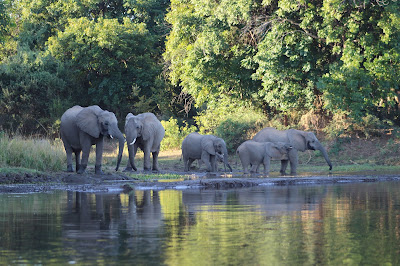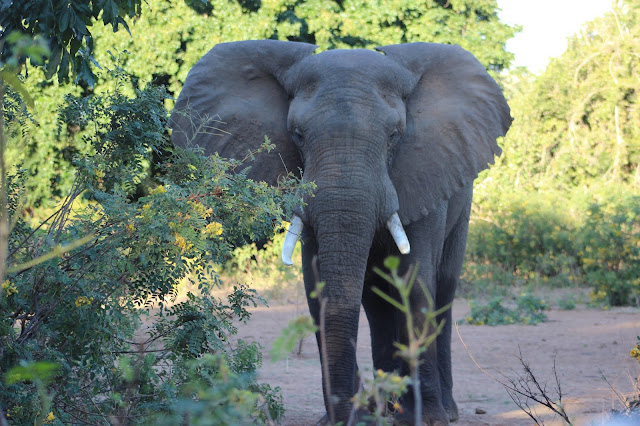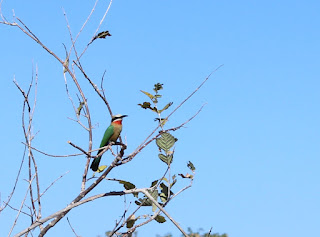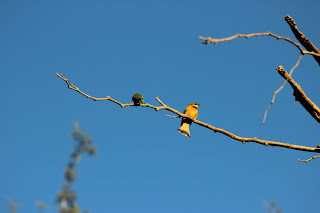It’s taken me the longest time to write about our adventures in Zambia, the fifth country of our safari trip. One reason is that life has sped up since our return, making our African sojourn seem impossibly long ago and far away. Another is that we had an amazing time there, and I’ve been struggling to carve out the time to do it justice. But at last, here is the fourth – and last – installation of the Szakos on the Road Southern Africa blog.
The only way to get to the Royal Zambezi Lodge is by private plane or boat. We flew on a commercial flight from Livingstone, Zambia, to the capital Lusaka, where our little charter plane was waiting for us. At the other end, we flew in circles while safari vehicles raced down the landing strip, making sure no wildlife were in the way of the plane. What a greeting!
A ten-minute drive through the bush, along the edge of the Lower Zambezi National Park, and we were at the lodge, where each family was guided to a tent that would be our home away from home. The tents define the word “glamping” – up on a wooden platform, canvass on a wooden frame, furnished with a queen bed draped with mosquito netting, and featuring a shower whose water is heated in a solar powered tank nearby. In front of our tent, a small plunge pool (much too cold to use on these winter days) and a tree where vervet monkeys slept at night. Just beyond the tree flowed the mighty Zambezi River, complete with resident hippos whose grunts and splashes woke us each morning. Across the river was Zimbabwe, and the Mana Pools National Park.
Meals and group activities took place on the terrace of the main lodge, and we were instructed that we should never walk in the dark to or from our tents without a guard. We later discovered why. In the middle of the second night, we were woken by the monkeys in front of our tent. They hooted and shook the branches, and we grumped good-naturedly about interrupted sleep as we listened to men walking around outside, calling to one another in a language we couldn’t understand. In the morning, we learned that the monkeys’ calls were an alarm, and the men had found fresh leopard tracks in the sand of the camp. It was reassuring to know that no wild animal could sneak up on us unawares in the night. Thank you, monkeys.
Each morning and afternoon, we all had our choice of activity – game drive, boat safari, walking safari, canoeing, fishing, or DNA (doing nothing at all). I was so glad I had gotten a cortisone shot in my knee before the trip, since only those who could run if they had to were allowed to do the walking safari. I chose that activity the first day, while Joe went on a game drive. The walk is fondly called the “birds and turds” safari, as much of our attention was on small creatures and the tracks and scat of the larger animals. Our guide, Chris, intentionally avoided animals who might attack us, and we were accompanied by a local park ranger with a gun, just in case. We still saw zebra, various antelope and other herbivores.
A highlight of the walk was learning about the termites who make the giant termite mounds. They are known as fungus farmers, as the mound is built to sustain and feed a giant fungus. Who knew? Their society is quite complex, with workers, soldiers, a king, and a queen who can live as long as 60 years! Every year, after the first rain, flying alates go out to mate, carrying some of the fungus on their body. If they are successful, they try to implant their fungus in a new location and build a mound to raise their offspring and feed the fungus, becoming king and queen of the new colony. If you want to learn more, here’s a good summary:
http://fascinatingafrica.com/species/termites-fungus-growing/.
 |
| Me and Joe in front of a fungus farm/termite mound |
We also saw Matebele ants, named after a warlike Zulu tribe,who march in long formations like soldiers, staging attacks on termite colonies; dung beetles, who roll balls of impala and elephant poop around on the ground; drywood termites, who cover a twig with dirt and feces before eating the new wood inside, leaving a twig-shaped hollow straw behind; and carnivorous ant lions, the larval form of an insect that matures into a dragonfly, who lie in wait under the sand after digging small conical pits, ready to jump out and grab any unwary ant that wanders in. Chris dribbled grains of sand into an ant lion trap to fool it into an attack while we watched. It was tiny, but formidable, and very, very fast. An ant wouldn’t have had a chance.
 |
| An ant lion trap |
 |
| An ant lion (not my picture) |
Chris took us through a large, mostly barren area that was once a Nsenga village, led by Chief Mburuma, which was evacuated in 1952 after a terrible sleeping sickness epidemic. The land was later included in the national park, but its legacy as a village is still visible: villagers through the generations swept their yards of dirt and debris, eventually sweeping away all the topsoil. Even grass has a difficult time taking root there. We found a fragment of pottery on the ground from the people who once made their home here.
And the poop and prints!
 |
| Impala poop |
 |
| More poop |
 |
| Leopard poop and prints |
We saw the scat and tracks of elephants, zebra,
civet, kudu, mongoose, impala, warthogs, baboons, and leopards. We saw an aardvark hunting burrow, and a warthog skull. At one point, we heard impalas give their danger barks, and at another, baboons hooted in alarm, and our armed guard became very alert, with the 360° awareness of a presidential secret service agent. The causes of the concern never showed themselves, though, and we didn’t have to prove our ability to run.
 |
| Anthony, keeping us safe |
We saw the larger animals from the safari truck and the boat. While not as crowded – with vehicles or wildlife – as Chobe, the Lower Zambezi is home to an incredible array of species. It is made up of river valley, thickly vegetated bush, savanna plains, and the Zambezi Escarpment, a geological cliff formation that demarks the edges the rift valley. A UNESCO World Heritage site, the National Park abuts several privately-owned game reserves that also were available to us. I've included lots of pictures at the end of this post.
Our most dramatic adventure was the encounter with an angry – and fast – bull elephant. Chris was driving us in a safari truck. Joe and I were in the back seats; we rotated every time, so everyone would get a chance to sit in front by the guide.
We came around a bend in the track and saw that the way was blocked by an elephant. About 35 years old, he was in musth – the male version of heat. When males are in this state, they are loaded with testosterone and aggression, and can think of nothing but finding a female and having sex. This makes them very irritable when they are disturbed or thwarted in any way. They have been known to take down stone walls and trees, and will charge at the slightest provocation. Elephants in musth extrude fluids from glands on their face, and leak urine as they walk, causing them to really stink. Nothing says “I’m sexy” to a female elephant like urine all over your back legs, I guess.
Anyway, this fellow was not particularly pleased to see us. Chris quickly made a six-point turn to head the vehicle in the direction we’d come from, for a ready escape. He said we could take pictures, as long as we didn’t talk or stand up. I focused my camera out the back of the vehicle – closest to my subject – and started taking pictures. Suddenly, I saw a different look come into the elephant’s eye: a switch from annoyed to homicidal. He trumpeted and flung his trunk over his right tusk and feinted a charge once before setting out in a full run in our direction.

Chris hit the accelerator, but on the sandy track, the wheels spun for way too long before finding traction and lurching us away. The elephant ran right at us, and followed us, keeping pace much farther than I had thought possible. Finally, we outran him. Later that afternoon, one of the young men in our group showed us on his iPhone where his fitbit had tracked his heart rate. There was an impressive spike for the elephant charge!
 |
| Our last view of our pursuer |
Birds!
I’m not a big birdwatcher, but even I was blown away by the number and variety of birds in the Lower Zambezi. Hadeda and sacred ibises, darters, go-away birds, red breasted bee-eaters, blackwing stilts, sea eagles, red billed and ground hornbills, African harrier hawks, fork-tailed drongos, trilling cisticolas, thick-knees, guineas, greater blue-eared starlings, open bills, spurfowl, kori bustards, red-billed quelea, geese and ducks, marabou and other storks, blacksmith lapwings, ring-necked doves (whose call in the morning is “Work harder! Work harder”, but in the evening is “Drink lager! Drink lager!), and my personal favorite, the lilac breasted roller. And that’s just the ones whose names I was able to write down!
Endangered dogs and more rare sightings
Other highlights of our safari drives were a chance to see a side-striped jackal, very shy and not often seen, and to watch a resting pair of rare, critically endangered wild dogs, digesting after eating half an impala. We also got our best view of zebras. Usually very skittish, these for some reason decided to stay and watch us before darting impala startled them into flight.
 |
| Side striped jackal |
 |
| Wild dog |




 |
| Zebra |
On our last day, we saw the most dangerous animal of our trip. Fortunately, we were safely aboard our safari truck when it crossed the road in front of us: a six-foot long black mamba snake. You might be able to make it out in this picture as it climbs the hill beside the road. They say a single bite from a black mamba contains enough neurotixin to kill more than a dozen grown men.
 |
| Black mamba slithering away |
Final thoughts on safari
What a magical trip – and such a privilege to see so many wild animals in their natural habitat. We hope that our presence – and our dollars – helped local efforts to preserve these beautiful creatures, but there is cause for pessimism. Throughout our travels in the five southern African countries, we were continually reminded of how climate change and human impact are eroding habitats and threatening both animal and human futures. We came home even more committed to doing our part to conserve, educate and advocate wherever we go. We hope you will do the same.
 |
| With Chris - guide extraordinaire |
 |
| Hippo mother and child |
 |
| Wild kingdom - warthogs, Impala, ibis |
 |
| Impala fighting |
 |
| Crocodile waiting for dinner |
 |
| Baboon mother and child |
 |
| Yes, birds keep the bugs off, but this is ridiculous! |
 |
| Baboon colony at the foot of the Zambezi Escarpment |
 |
| Baboon making sure we don't get to close |
 |
Hippo leaving the water
Female lion resting in the sun |
 |
| An unlucky young male after an encounter first with a kicking water buffalo and then with a porcupine (note the quill in his mouth). Injured and hungry, he may not make it. Our guide alerted the wildlife vet who serves the park, but treatment may not come in time. |
 |
| Elephants taking an evening dip |
 |
| Multi-generational recreation |
 |
| Canoeing on the river |




















































Comments
Post a Comment